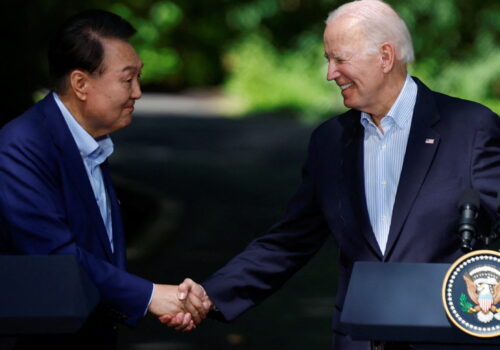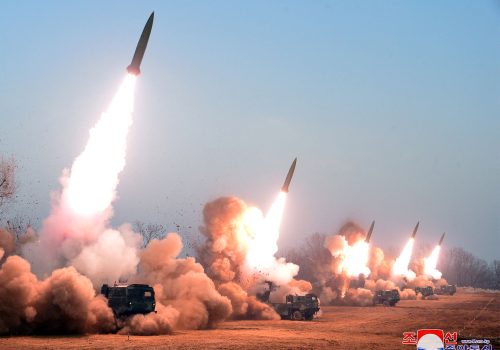A US-South Korea alliance strategic memo on deterrence
TO: Republic of Korea minister of national defense, US secretary of defense, and the ROK-US Military Committee
SUBJECT: Strengthening ROK-US alliance deterrence against North Korea
Bottom line up front: Deterrence of North Korean aggression against the Republic of Korea (ROK) is growing increasingly complex and difficult, as North Korea’s nuclear and nonnuclear strike capabilities rapidly expand and as Pyongyang builds its policy justifications for “preventive” escalation. Meanwhile, the actions of the People’s Republic of China (PRC)—and its potential to attack Taiwan—are increasingly likely to further undermine deterrence of North Korean aggression. In light of these challenges, the ROK and the United States should go beyond reinforcing long-standing threats of punishment, and instead build new deterrence approaches to ensure the alliance is: clearly resilient in the face of attack; ready to quickly defeat aggression beyond “provocations” but short of war; and prepared to deter North Korea even during a US-PRC war.
Background: Deterrence faces new challenges, but alliance is reinforcing same approach
There is now strong agreement in the ROK-US alliance that North Korea’s evolving military capabilities and changes to its doctrine pose an increasing challenge to deterrence of North Korean aggression, particularly nuclear aggression or aggression backed by the threat of nuclear escalation.
- North Korea’s growing ability to strike the United States with nuclear-tipped intercontinental ballistic missiles (ICBMs) is often cited as first among those challenges, particularly as it tests mobile solid-propellant ICBMs suited for “second strike” deterrence. Some South Koreans fear that Washington, seeing the credibility of the threat of nuclear retaliation against US cities increasing, would be reluctant to back South Korea in a military confrontation.
- Growing North Korean tactical nuclear capabilities also give Pyongyang a wider range of options to threaten South Korea with nuclear attack at a threshold it might believe would not automatically trigger massive US nuclear retaliation. As our contributor, Jung Jae Kwon, has noted, this means that the “alliance must cope with the possibility of North Korea using tactical nuclear weapons in order to achieve military or political objectives without triggering American nuclear retaliation.” Meanwhile, North Korea’s nonnuclear capabilities to launch limited surprise attacks against South Korea continue to improve, as demonstrated by its tests of more capable short-range solid-propellant missiles and its drone incursions, for example.
- North Korea’s policies and rhetoric also are increasingly signaling its intention to escalate. In September 2022, Pyongyang’s new “Law and Policy” on nuclear weapons laid out a range of scenarios where it would be justified in using nuclear weapons first, including threats to the regime “on the horizon” or to “retake the initiative” in an ongoing conflict. Besides the risk of nuclear strikes, these intentions and capabilities also create a dilemma for deterring limited nonnuclear aggression, particularly ambiguous “gray zone” threats like cyberattacks or incursions with drones. Using nuclear threats as a backdrop, North Korea could escalate aggression against South Korea, calculating that neither Seoul nor Washington would be willing to risk war in response.
Beijing also has been posing new challenges for deterrence of North Korean aggression against the ROK, though this is not acknowledged as openly as the challenges posed by North Korea’s weapons and policies. Beijing has increasingly provided political cover for North Korean provocative behavior, and helped it to evade UN Security Council sanctions, thereby enabling its weapons programs’ advancements. Meanwhile, rising strategic competition between the PRC and United States means that the alliance must be prepared to deter Pyongyang in scenarios where Washington is simultaneously confronting Beijing.
- As South Koreans including President Yoon Suk Yeol have noted, North Korea could seek to take advantage of a PRC-US conflict over Taiwan with aggression against the ROK.
- Some American analysts also worry that the PRC could encourage North Korea to escalate as a way to tie down US forces that could otherwise interfere with PRC operations against Taiwan. A recent Atlantic Council study notes that, beyond these scenarios, a prolonged conflict over Taiwan is still likely to spread to engulf the Korean peninsula.
In the face of these challenges, though ROK and US leaders are visibly working to strengthen deterrence, they are doing so in ways that may not directly address the evolving nature of these threats—and that could just incentivize North Korea to escalate first in the event of a crisis. So far, the primary solution to increased deterrence challenges has been to reinforce existing approaches: strongly reemphasizing “deterrence by punishment”; bilaterally warning that any nuclear attack on the ROK would result in the “end of that regime”; and by publicizing deployments of US strategic military assets to the peninsula like ballistic missile submarines and bombers. Meanwhile, Seoul’s officials continue to threaten preemption, regime decapitation, and “massive punishment and retaliation.” Though such statements and displays may be reassuring to the ROK domestic audience, such threats:
- May not outweigh the incentives North Korea has to escalate first, even to tactical nuclear strikes, in a confrontation or conflict where it believes the regime’s survival is already at stake.
- Do not close a potential gap in the credibility of the alliance’s response options at levels short of full-scale war—if North Korea escalates beyond typical provocations while leveraging the threat of nuclear escalation to discourage a strong and unified alliance response.
- May lack credibility in the context of a US-PRC conflict, if North Korea believes that the ROK-US alliance is unprepared to confront North Korea during a PRC-US conflict.
Recommendations to strengthen alliance deterrence with new elements
Many ROK and US experts and former officials agree on the need to strengthen alliance deterrence.
- As former commander of US Forces Korea, Gen. (US Army, retired) Curtis “Mike” Scaparrotti notes: “The steady expansion and growing lethality of North Korea’s nuclear capability and their recent declarations of first use nuclear policy, coupled with the US-PRC tensions in the broader Indo-Pacific region, present an extremely complex security environment—one that has not been fully addressed by the Alliance.”
- From the perspective of Sang Hyun Lee, president of the Sejong Institute and a former ROK government official: “North Korea’s increasing nuclear weapons capabilities pose an existential threat to the ROK, and South Koreans consistently support the development of their own independent nuclear weapons capability . . . but this is not yet politically feasible. The most realistic option for now is for the alliance to strengthen both US extended deterrence and South Korea’s own nonnuclear deterrence.”
To strengthen deterrence in the context of these factors, the alliance should visibly:
- Ensure the resilience of alliance military forces to reduce any perceived vulnerability to surprise attacks and limited nuclear attacks—thereby decreasing North Korea’s incentive to escalate first.
- Enable alliance readiness to quickly counterattack against limited North Korean aggression without the need to take the risk of transitioning to a full-scale war footing.
- Counter Beijing as an enabler of North Korean aggression by demonstrating preparedness to deter and defeat North Korean aggression even during a US-PRC conflict.
Ensure resilience of alliance military capabilities to surprise attacks and tactical nuclear attacks: To ensure ROK-US military capabilities on the Korean peninsula do not appear vulnerable to North Korean escalation—particularly tactical nuclear attacks—the alliance must take visible steps to improve its resilience. To this end, the alliance should:
- Ensure that key elements of South Korean military forces and US Forces Korea (USFK) are more survivable to reduce their perceived vulnerability to a surprise attack. This should include improved active countermissile and counterdrone defense measures, but also improved passive defense measures such as hardening, dispersion, and deception. Reducing perceived vulnerabilities of fixed command and control facilities is particularly critical to avoid North Korea thinking that a surprise attack, with or without nuclear weapons, would be sufficient to cripple the alliance’s ability to command and control its forces. Ensuring the visible readiness and dispersion of land- and sea-based mobile missile forces on and around the peninsula could also be key to ensuring that Pyongyang does not believe neutralizing alliance bases in surprise attacks would be sufficient to prevent effective strikes on key targets deep inside North Korea.
- Establish the clear preparedness of the alliance to respond to and overcome North Korean tactical/limited nuclear attacks. The new ROK-US Nuclear Consultative Group and associated alliance mechanisms can strengthen deterrence by helping to make it clear that a North Korean nuclear attack will not politically or militarily defeat the alliance. These mechanisms should aim to ensure that nuclear responses to North Korea will take place in an alliance framework of close coordination between the ROK and the United States that accounts for potential nuclear strikes and responses, demonstrating to Pyongyang that it cannot expect to divide the alliance’s leaders or disrupt its military operations through either the threat or employment of nuclear weapons. The alliance should also periodically conduct its annual exercises in scenarios where North Korea launches a nuclear attack, as the November 2023 Security Consultative Meeting communiqué noted is already under discussion. At the tactical level, ROK and USFK units should regularly and visibly train to continue to operate effectively in nuclear-contaminated environments.
Enable quick, combined, and calibrated alliance military responses short of war: To prevent North Korea from seeing a gap in alliance response capability in situations beyond an ROK-only provocation response but still short of a full-scale war that would risk a nuclear exchange, the alliance must show it can fight and win a limited military exchange without transitioning to the wartime ROK-US command and control posture. As a recent Atlantic Council study described, the requirement is for “quick, combined, and calibrated” responses: quick enough that they can be executed without considerable delay for additional preparations; with combined ROK-US military forces operating together instead of ROK or US forces operating unilaterally; at an appropriate level of intensity that is neither so weak as to essentially hand a victory to Pyongyang but not so disproportionate as to run an unacceptable risk of triggering nuclear retaliation. To make this possible, the alliance should:
- Establish, regularly exercise, and display a standing operational military headquarters with the authority, responsibility, and capability to control an ROK-US alliance military response to a limited scenario short of war. This headquarters would lead the response to North Korea in scenarios where activating the full wartime ROK-US alliance military structure would be excessive but where Seoul and Washington agree a small-scale unilateral ROK military response is insufficient.
- Ensure and demonstrate the day-to-day readiness of ROK and US standoff precision-strike capabilities to respond decisively to any surprise limited North Korean aggression. These conventional precision-strike assets should have the clear ability to rapidly destroy targets deep within North Korea without having to take escalatory and time-consuming measures to defeat North Korean air defenses, meaning these would be airstrikes by stealth aircraft from “standoff” ranges or missiles from land- or sea-based launchers. The targeting of these strike assets should be able to be rapidly tailored to the situation based on bilateral guidance from the national leadership rather than, for example, a list of predesignated targets for “massive punishment and retaliation.” This would require their connection with alliance command, control, communications, and intelligence capability to enable effective allied short-notice counterstrikes. At the same time, the alliance’s language and drills should focus on implementation of calibrated responses so these strike assets can be used reliably when needed but without automatically generating escalatory dynamics and creating a “use-it-or-lose-it” dilemma for the Kim regime and its nuclear arsenal.
Countering Beijing as enabler of North Korean escalation: To prevent a PRC-US military confrontation from undermining deterrence of North Korea, Seoul and Washington must clearly show that they are prepared for such a scenario. Further, they should also work to convince Pyongyang that a US conflict with the PRC is not a moment of opportunity and convince Beijing that encouraging Pyongyang to open a “second front” in Korea would backfire. To make this possible, the alliance must overcome its aversion to discussing such “sensitive” issues as part of the normal public discourse on alliance military preparations and training, and instead the alliance should:
- Explicitly acknowledge that the alliance must prepare to deter, and if necessary, defeat North Korean aggression and adventurism in the event of a PRC-US conflict. ROK-US alliance military forces already explicitly prepare and train to deter, and if necessary, defeat a North Korean attack against the ROK in isolation. Meanwhile, the threat of PRC aggression is the explicit “pacing threat” for which the US military prepares to deter, and if necessary, defeat. Yet, the alliance has still not explicitly acknowledged that it must prepare for both at the same time.
- Normalize including scenarios of deterring and defeating North Korea during a PRC-US conflict in routine alliance activities. This includes making such scenarios part of periodic tabletop exercises and other elements of the alliance defense readiness and military training programs. Such normalization would also include making this topic an acknowledged part of normal ROK-US dialogues on deterrence and military preparedness, such as during the annual ROK-US Security Consultative Meeting and Military Committee Meeting.
- Ensure preparations to deter and defeat North Korea during a PRC-US conflict have wide involvement and are clearly communicated publicly. Even presuming that the alliance could fully and comprehensively prepare militarily for such scenarios quietly and secretly, it would not do much for deterrence if the intended audience cannot see enough to learn that such preparations are robust, in earnest, and have political backing in Seoul and Washington. The alliance need not be explicit about how such a situation would be handled, particularly not in public: some ambiguity on specifics could even be helpful for deterrence. However, to deter simultaneous conflicts with the PRC and North Korea, Beijing and Pyongyang must be fully convinced that the alliance is politically and militarily ready to deal with such a scenario.
About the authors
Markus Garlauskas is the primary author and director of the Atlantic Council’s Indo-Pacific Security Initiative, housed in the Scowcroft Center for Strategy and Security.
Lauren Gilbert is the co-author and deputy director of the Indo-Pacific Security Initiative.
Jung Jae Kwon is a contributor and PhD candidate at the Massachusetts Institute of Technology’s Department of Political Science and Security Studies Program. He is currently a Stanton Nuclear Security Research Fellow at the Project on Managing the Atom and the International Security Program at Harvard Kennedy School’s Belfer Center.
The research for this policy memorandum was made possible by the support of the Korea Foundation, but it represents the views of the authors rather than those of the Korea Foundation, the Atlantic Council, or any government entity.
Related content

Indo-Pacific Security Initiative
The Indo-Pacific Security Initiative works with US, allied, and partner governments and other key stakeholders to shape strategies and policies to mitigate the most important rising security challenges facing the region, including China’s growing threat to the international order and North Korea’s destabilizing nuclear weapons advancements. IPSI also addresses opportunities for cooperation in the region, such as transforming regional security architectures, harnessing emerging technologies, and developing new mechanisms for deterrence and defense cooperation.
Image: Intercontinental ballistic missiles (ICBM) are driven past the stand with North Korean leader Kim Jong Un and other high ranking officials during a military parade marking the 105th birth anniversary of country's founding father Kim Il Sung, in Pyongyang April 15, 2017. The missiles themselves were shown for the first time inside a new kind of canister-based launcher on Saturday. The trucks upon which they are mounted are originally designed to move lumber. REUTERS/Damir Sagolj


